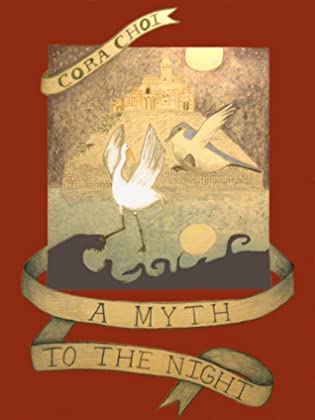I was immediately drawn to A Myth to the Night because of the amazing cover art. It looked beautiful, and the synopsis made it sound amazing. It is amazing… in theory and in concept, but in execution, not so much. There are some serious flaws with world building and the major conflict of the novel has a huge glaring plot hole that makes me wonder if the author really thought this through.
Hugh Fogg is the main protagonist of the novel. He has been a phantom for near 400 years, having been a victim of a massive massacre that took place in the 1600s. He was a monk in the more genteel order of the world, the Order of the Crane. The Order of the Shrike was the second world order that was responsible for the murders of the monks. Immediately, we see that Choi decided to create a simple black-and-white dichotomy of the world, where you are either a Crane or Shrike, good and brave or evil and cowardly. There are no other orders, no other choices. This in and of itself is not a problem, but it does become problematic when you realise that a good deal of the characters will fall into a grey, in-between category. They are not brave or good or evil or cowardly, yet simply are. It’s detrimental to the novel as a whole when everything is so black and white that the many greys written about in the novel are neglected.
After the massacre, Hugh remained on the island he was murdered on in order to fulfill one last task. While he lived, he was charge with preserving a myth called The Slayer of the Shadow of Fear. It is a basic prophecy detailing how one person will rise up and defeat the Shadow of Fear, literally an all consuming fear that is brought on when someone is overwhelmed with fear/anxiety. This Shadow of Fear forces the one it contaminates to kill themself, and then turns their soul into a demon like creature that is never free to rest. This is an amazing concept that I really loved. It was well done and well crafted. The idea that you are your own worst enemy for letting your fears and anxieties control your life is incredibly relevant, especially when you consider the age group this is marketed for. Disseminating the message that you can overcome your fears and that standing up for yourself and pushing on is possible and can lead to happiness is something that the YA audience desperately needs to hear and believe.
Sadly, this was the best part of the book and the only well-crafted and thought out piece. You see, there are other phantoms on the island with Hugh, but they were never really alive. They are actually characters from famous myths, legends, folk tales, and fables. The Order of the Shrike destroyed all of their books and stories once they took over control of the world via the massacre of the Order of the Crane. With no one to inspire, they rose from the burnt pages they belonged to and haunted the island alongside Hugh, waiting for their tales to be told once again. THIS is the most problematic part of the novel. This is where more thought should have been placed by Choi and by her editor. Supposedly, these phantoms and their stories are the only way people can overcome their fears and defeat their Shadow of Fear. When they hear about these amazing stories and feats of strength, they are inspired to stand up to fear. It provides a cathartic experience. Since these stories no longer exist, people no longer have a way to defend themselves or inspire themselves against the Shadow of Fear. Now, if the world that Choi created was a darker world with no forms of entertainment and the residents resembled the masses in The Giver, then I could understand the need. It would make sense and it would make the entire story work. But, that isn’t the case. There is still entertainment in the world, “Only names like James Dean and Elizabeth Taylor were on the lips of the students.” Well, if the masses have access to cinema, then wouldn’t they have access to stories? Wouldn’t these alternate forms of entertainment offer the same defense against fear as these parables once did? It seems as though the entire world remains the same, we have internet access, we have television, we have movies, books still exist, yet through all of these different mediums, not a single story showing a person overcoming their fear exists? It makes no sense at all. This is where the entire novel falls apart and the premise becomes nonsensical. Did the author realise such a plot hole existed? Did she come up with an excuse for it, but simply forgot to mention it in the novel? Did she hope no one would notice? Or perhaps she hoped readers would assume this was all thanks to some overreaching metaphor that certain classical books are more essential than anything else that can be created. Either way, this was something that desperately needed some explanation, yet it never came.
Apart from that, the story was enjoyable and fast-paced. Characters were fun, action came easily, and the story, though various detours, never halted.

 A Myth to the Night - Part I by
A Myth to the Night - Part I by 






